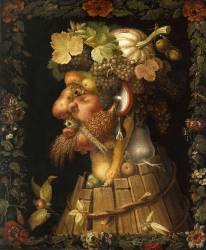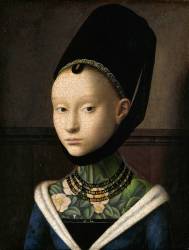Renaissance paintings
The Renaissance was a major artistic movement that originated in the 14th century and lasted until the 16th century. It radically transformed the history of Western art, marking a break with the Middle Ages and a passionate rediscovery of the ideals of classical antiquity. This style is characterised by a quest for realism, through the introduction of linear perspective, an in-depth study of human anatomy, and the use of light and colour. Renaissance artists such as Leonardo da Vinci, Sandro Botticelli, Michelangelo and Raphael placed man at the centre of their concerns and their paintings, exploring his beauty, complexity and potential, while continuing to treat religious themes with a renewed sensitivity. Renaissance art is a vibrant testimony to the intellectual and artistic effervescence of a pivotal era.
Enhance your interior with the timeless splendour of a 14th, 15th or 16th century Renaissance painting thanks to Muzeo's exceptional reproductions. Each work, whether an oil painting or another technique, is produced with remarkable fidelity and meticulous attention to detail, then carefully framed in our Parisian workshops, guaranteeing a high-end product for your wall decoration. Introducing a poster or canvas inspired by the great artists of this golden age, such as Leonardo da Vinci or Sandro Botticelli, is like inviting a piece of art history, a touch of sophistication and cultural depth into your home. Our works are a true impression of artistic greatness, designed to stand the test of time and bring a majestic effect to your space, reflecting the richness of Italian, Dutch and European painting as a whole.
The artistic revolution of Renaissance painting
The Renaissance, a period of profound cultural and artistic transformation in Europe lasting from approximately the 14th to the 16th century, saw painting reach unparalleled heights of innovation and mastery. The Renaissance movement, which originated in Italy, redefined the way art was conceived and created, laying the foundations for Western art for centuries to come. Artists of this period broke with Gothic conventions, drawing inspiration from humanism and ancient models to create a style in which man, nature and perspective played a central role.
The use of oil paint on canvas, perfected by Flemish painters such as Jan van Eyck and sublimated by Italian painters such as Leonardo da Vinci and Sandro Botticelli, made it possible to achieve a richness of colour and a fineness of detail that had previously been impossible, giving the paintings a striking realism. This technique offered greater flexibility and the possibility of superimposing layers of paint, enriching the texture and light of the works.
Origins and evolution of the Renaissance style
The emergence of Renaissance painting is intrinsically linked to the intellectual and social context of Italy. Cities such as Florence and Rome became centres of intense artistic activity, supported by wealthy patrons, the Church and guilds. The first signs of this artistic revival can be seen in artists such as Giotto, who, from the 14th century onwards, began to infuse his paintings with greater naturalism and emotion. However, it was in the Quattrocento (15th century) that the principles of the Renaissance fully asserted themselves. The rediscovery of ancient texts, the study of mathematical perspective by architects such as Brunelleschi and theorised by Alberti, and a growing interest in human anatomy profoundly influenced painters.
Italian Renaissance art is characterised by its clarity, harmony and balance, seeking to represent the world in a rational and idealised way. The style of this painting marked a turning point in the history of art. The Renaissance artists' mastery of light and colour enabled them to create works of unparalleled beauty and depth, each painting being a window onto an idealised but tangible world. This artistic technique thus defined a new era for the arts in Europe.
Major Renaissance artists and their iconic works
The Renaissance was the breeding ground for an impressive number of artistic geniuses. Among them, Leonardo da Vinci (1452-1519) embodies the ideal of the universal Renaissance man. His works, such as the Mona Lisa and The Last Supper, are masterpieces of composition, psychology and light, particularly with his sfumato technique.
Michelangelo (1475-1564), although he considered himself primarily a sculptor, left behind monumental paintings, notably the ceiling of the Sistine Chapel with the famous scene of The Creation of Adam. His powerful and expressive style highlights the musculature and human drama.
Raphael (1483-1520) is famous for the harmony, grace and formal perfection of his works, particularly his numerous Madonnas (the Virgin and Child) and the frescoes in the Vatican Chambers, such as The School of Athens. The vibrant colours of his paintings and his mastery of perspective make him a pillar of the High Renaissance.
We can also mention Sandro Botticelli (1445-1510), with iconic paintings such as The Birth of Venus and Spring, who created a unique style imbued with lyricism and melancholic grace, often inspired by mythology. The figure of Venus has also become an icon of Renaissance art, often associated with Sandro Botticelli, whose oil on canvas painting had an exceptional impact on the art world.
In Northern Europe, artists such as Jan van Eyck (c. 1390-1441) revolutionised the technique of oil painting, achieving a stunning level of detail and realism, as evidenced by The Arnolfini Portrait. Hieronymus Bosch (c. 1450-1516), with his fantastical and moralising triptychs such as The Garden of Earthly Delights, offered a unique and enigmatic vision, very different from Italian art. In France, artists such as Jean Fouquet (c. 1420-1481) and Jean Clouet (c. 1480-1541) adapted Italian innovations to French tastes until the 16th century, excelling particularly in the art of portraiture.
The impact of Renaissance techniques and themes on wall decoration
The legacy of Renaissance painting is immense. Not only did it define the canons of beauty and representation for centuries, but it also elevated the status of the artist from craftsman to creative intellectual. The techniques developed, such as perspective and chiaroscuro, have become fundamentals of art education. The impression left by this art can still be felt today. Incorporating a reproduction of a Renaissance work into your wall decoration is like bringing a piece of this rich artistic history into your home.
A painting from this period brings a touch of elegance and timeless culture. The depth of perspective in a mythological scene, the richness of colours in a portrait and the finesse of detail in a Renaissance oil painting capture the light. Muzeo will showcase these works, whether they depict the Virgin Mary, a saint, Adam and Eve, or an illustrious figure of the time, such as a portrait of a statesman or an artist's muse. Choosing a Renaissance painting means choosing a style that has stood the test of time, as the effect of such a painting in an interior is always striking. These visual arts from the 16th century and earlier periods of the Italian and European Renaissance are now available as high-quality reproductions. Renaissance artists sought to capture the essence of their subjects, a quest that makes each work so captivating.
Choose your Renaissance masterpiece to enhance your walls
Incorporating a reproduction of a Renaissance painting into your interior is a statement of taste in art and history. A portrait by a Flemish artist such as Jan van Eyck or a French artist such as Jean Clouet can add depth to an office. A work by Sandro Botticelli, with its ethereal figures such as Venus and delicate colours, can create a poetic atmosphere, while Michelangelo's compositions or Raphael's paintings can become focal points in large spaces. Leonardo da Vinci's scenes or Hieronymus Bosch's unique visions stimulate the imagination.
Consider the scale of the work and its frame, which should harmonise with the overall style of your décor. A reproduction of an oil painting on canvas from the Italian Renaissance or elsewhere in Europe offers unparalleled visual richness. The techniques of light and perspective employed by these 15th- and 16th-century artists create an effect that enlarges the space. At Muzeo, each painting is created with attention to colour fidelity and print quality, ensuring you receive a piece of art that honours the original. Renaissance art captured the essence of its century with an artistic mastery that continues to amaze us today. Let Renaissance painting transform your interior space.















































































































































